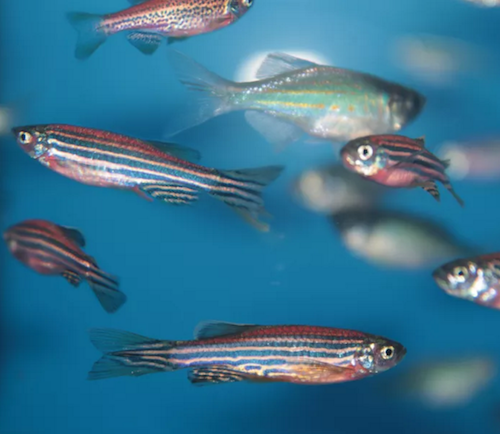|

CLICK ON weeks 0 - 40 and follow along every 2 weeks of fetal development
|
||||||||||||||||||||||||||||
|
Developmental Biology - Chronic Stress & Disease Chronic Stress & the Klf9 Gene The Coffman team found that chronic cortisol exposure affects gene activity mainly via the glucocorticoid receptor (GR), a transcriptional regulatory protein (meaning a protein responsible for orchestrating gene activity) that is activated by cortisol. They also found upregulation of pro-inflammatory gene activity in cortisol-treated zebrafish depends as well on a GR target gene called klf9, another transcription regulator. "In healthy individuals the immune system behaves like a well-regulated militia that responds rapidly to the body's commands to mobilize or stand down. Mounting an inflammatory response only as long as needed to clear an infection or stimulate wound healing. We believe it is a key gene in optimizing regulation of inflammation and how it is compromised by early-life stress." In humans, chronic stress can be caused by psychosocial factors such as trauma, economic adversity or the struggle to cope with abusive circumstances, Coffman said. He noted that such stress, which is already endemic in many communities, is currently being exacerbated by the COVID-19 pandemic. The identification of klf9 as a key regulator of the physiological response to cortisol builds on earlier research in which Coffman showed that chronic exposure to cortisol early in life has persistent effects on the stress response system that compromise the regulation of key immune system genes controlling inflammation. The paper based on the new research was recently published in Scientific Reports, an online journal from the publishers of Nature. Zebrafish were used as the model animal as they are relatively easy and economical to work with and because they share their stress response system with humans, along with the associated regulatory genes and gene circuitry. In his earlier studies, Coffman found that zebrafish larvae treated with cortisol for the first five days of life had increased proinflammatory gene activity and gave rise to adults with a dysregulated immune response. Coffman is especially intrigued by the role that klf9 may play in "inflammaging," a chronic, low-grade inflammation that is believed to accelerate aging and exacerbate many age-related diseases. In the future, he would like to explore the role of klf9 in age-related neurodegenerative diseases such as Alzheimer's. Another potential area for investigation is klf9's role in regeneration. Because regenerative ability has been found to depend on the immune system, a better understanding of the immune system's response to stress could help explain the connection between chronic stress and impaired healing ability. "This new study on klf9 highlights the potential between scientists working in aging and regeneration, the lab's two areas of research. It also demonstrates the importance of basic research: science will only be able to develop new therapies for treating aging and age-related disease by understanding their underlying mechanisms." The study was enabled by the CRISPR gene editing technology, which allows scientists to create genetically modified mutant animal models with the attributes they are seeking to study. In this case, zebrafish were developed in which the genes encoding the GR and Klf9 were deactivated, which allowed scientists to compare the stress response in normal fish with those of their genetically altered counterparts. Abstract The zebrafish has recently emerged as a model system for investigating the developmental roles of glucocorticoid signaling and the mechanisms underlying glucocorticoid-induced developmental programming. To assess the role of the Glucocorticoid Receptor (GR) in such programming, we used CRISPR-Cas9 to produce a new frameshift mutation, GR369-, which eliminates all potential in-frame initiation codons upstream of the DNA binding domain. Using RNA-seq to ask how this mutation affects the larval transcriptome under both normal conditions and with chronic cortisol treatment, we find that GR mediates most of the effects of the treatment, and paradoxically, that the transcriptome of cortisol-treated larvae is more like that of larvae lacking a GR than that of larvae with a GR, suggesting that the cortisol-treated larvae develop GR resistance. The one transcriptional regulator that was both underexpressed in GR369- larvae and consistently overexpressed in cortisol-treated larvae was klf9. We therefore used CRISPR-Cas9-mediated mutation of klf9 and RNA-seq to assess Klf9-dependent gene expression in both normal and cortisol-treated larvae. Our results indicate that Klf9 contributes significantly to the transcriptomic response to chronic cortisol exposure, mediating the upregulation of proinflammatory genes that we reported previously. Authors Ian Gans, Ellen I. Hartig, Shusen Zhu, Andrea R. Tilden, Lucie N. Hutchins, Nathaniel J. Maki, Joel H. Graber and James A. Coffman. Acknowledgements The authors declare no competing financial interests. The research was supported by grants from the National Institutes of Health (R03- HD099468, P20-GM104318, and P20-GM103423), by a Morris Scientific Discovery Award to Coffman and by a gift from The Linde Packman Lab for Biosciences Innovation to Colby College. About the MDI Biological Laboratory We aim to improve human health and healthspan by uncovering basic mechanisms of tissue repair, aging and regeneration, translating our discoveries for the benefit of society and developing the next generation of scientific leaders. For more information, please visit mdibl.org. Return to top of page. | Sep 21 2020 Fetal Timeline Maternal Timeline News  The zebrafish has recently emerged as a model system for investigating how over production of the hormone: cortisol, induces inflammatory stress response and compromises immune genes such as klf9. CREDIT In the public domain.
| ||||||||||||||||||||||||||||

